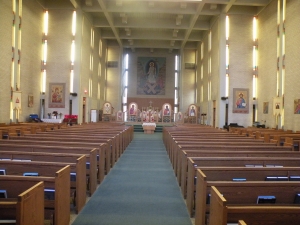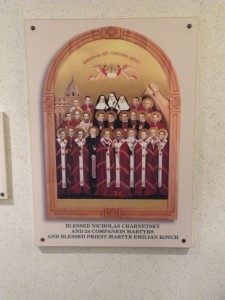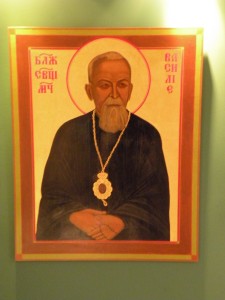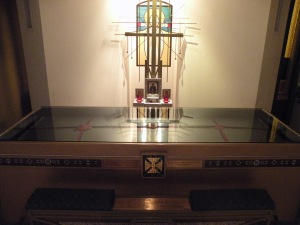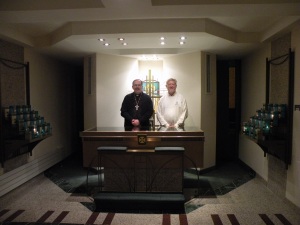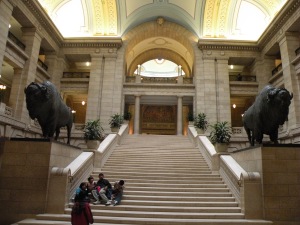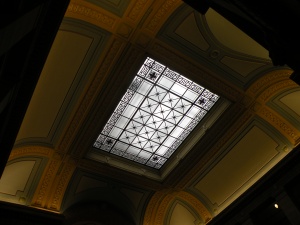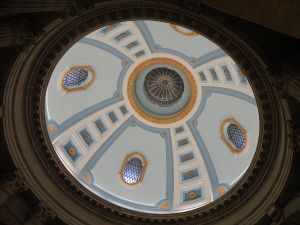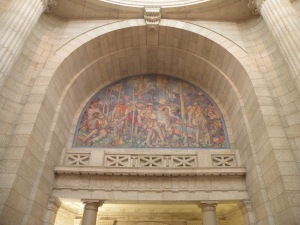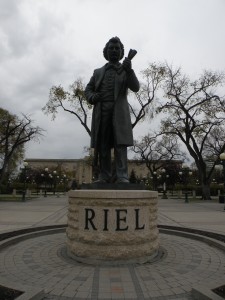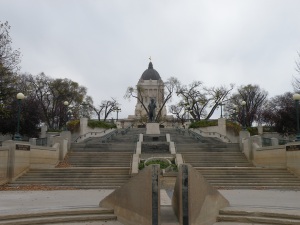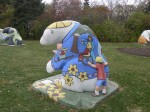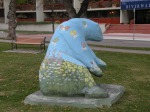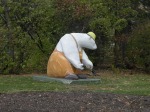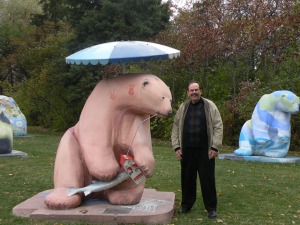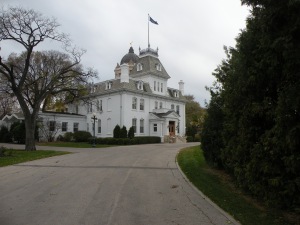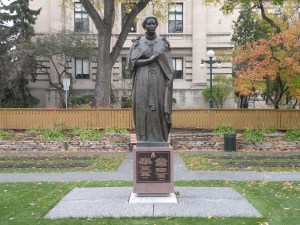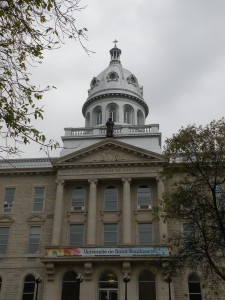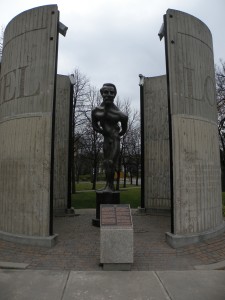Saturday afternoon – Albert arrived after 1:00pm at my door, knocking to let me know he was now free. It had been a long morning for him, an extra-innings meeting of pastoral importance, and then catching up with the confirmation class at the Archbishop’s House. Though a bit tired, still and all he was ready to go.
We piled into his car, and drove to the Ukrainian Catholic Cathedral of the Archeparchy of Winnipeg, hoping it would be open. Alas, as so many center-city churches, it was locked tight; and it being Saturday, there was no one around — the parking lot was empty save for us.
(You may have noticed by now that there are three — count them — three “Archdioceses” in Winnipeg! “Archeparchy” is the eastern rites’ name for “archdiocese”. If there are three Archdioceses, then there are three archbishops, three cathedrals! It is a very unusual situation, which I simply wanted to point out; I will refrain from exhaustive explanation of how this works!)
We moved on to our appointed activity — a tour of the Bishop Velychkovsky Martyr’s Shrine at St. Joseph Ukrainian Catholic Church.
Vasyl Veychkovsky was born in 1903 as a citizen of the Russian Empire under Csar Nicholas II. He experienced the tumult of World War I, the Russian Revolution, and the rise of the Soviet Union. He “grew up in a priestly family in Western Ukraine”, a member of the Ukrainian Catholic Church — an Eastern Rite Church in communion with Rome (thus, “Catholic“). “As a deacon, he joined the Redemptorists in 1924. The following year he was ordained a priest and began his missionary work, first by teaching in the Minor Seminary, and then preaching parish missions in Volyn and Halychyna, Ukraine”.
When the Germans invaded the Soviet Union in 1941, a number of Ukrainians (Eastern Europeans of Slavic origin, not Russian) threw off allegiance to the soviet and initially welcomed the Germans. “At the end of the Second World War” with the defeat of the Axis powers, “…a fierce persecution” under Josef Stalin began, in part as punishment of the Ukrainian people. “Father Vasyl was arrested when he refused to deny his faith. His harsh sentence of death by firing squad was later commuted to ten years in Soviet Labor camps” (what Alexander Solzhenitsyn called the “Gulag archipelago” — work camps above the Arctic Circle).
“Returning to Ukraine in 1955, Father Velychkosky worked clandestinely in the illegal underground Catholic Church”. In 1963, when the Ukrainian Catholic bishop was released from gulag and deported”, he “secretly ordained…” Father Velychkosky “a bishop in a Moscow hotel. Soon after (1969)”, Bishop Velychkosky “was arrested. His three-year sentence was filled with severe physical, chemical, electrical and psychological torture”. Never denying his faith or the Church, when released in 1972 “he was exiled from Ukraine”. Ailing from years of torture and deprivation, he was invited by the Archbishop of Winnipeg to come to Canada. There he traveled, taught, and wrote for the short time he had remaining in earthly life. He died in June, 1973, and was buried in Winnipeg. Even then he was considered a martyr for the faith. (Quoted sections are from the text of a brochure produced by and for the Shrine, www.bvmartyrshrine.com)
We were met at the door of St. Joseph Church by our guide, a young university student who works for the Shrine as assistant to the director. Speaking in English lightly accented by her Ukrainian origins, she lead us through the Shrine by way of the Church. Her explanations granted us access to the life of Bishop Velychkovsky (more detailed than above!). More importantly, she also shared the history of the work of the Shrine’s staff. Through ardent transcription of hand-written documents about and by the Bishop, lengthy summer travel to Ukraine and Russia to gain access to KGB documents, personal interviews of survivors (priests, nuns, laity) who knew the Bishop, and searches in Ukraine and Canada for objects which the Bishop had used in his ministry, they have pieced together a burgeoning archive of materials for their beloved Bishop and Martyr.
The Shrine is beautiful in its simplicity.
Our guide continued her informative and faith-filled explanations, showing us personal relics of Blessed Vasyl, from vestments, to the socks in which he was originally buried, to a personal manuscript which he was urged to write before he died. The wonder which came over a guide as she spoke and explained was moving; this was especially true when she described the process of disinterment of the original wooden casket which, in just days after exhumation, it was disintegrating but the body of Blessed Vasyl was found to be intact!
His remains are now sealed in a sarcophagus made of metal, encased under glass, as shown above.
While our guide left us momentarily to retrieve her camera, Archbishop Albert and I knelt in prayer before the sarcophagus. It was moving for me in a way unexpected as I held a number of folk whose lives are fraught with the challenge of disease in my heart and in prayer, asking Blessed Vasyl to intercede for them in their distress.
Upon her return, our guide gave each of us a packet of brochures, a relic of Blessed Vasyl, a bottle of oil touched to fabric which he had worn, and a book. We were both grateful. The requisite pictures were taken, and though reluctant to leave this holy site, our guide needed to be about other things, and there were parts of Winnipeg yet to unfold for this tourist and his guiding friend.
It was cloudy when we emerged from St. Joseph Church. We clambered into the car, and headed back west toward the central area of Winnipeg where the government buildings of Manitoba stand. Our destination: the Manitoba Legislative Building.
When we arrived, we parked one of the streets which encompass it. Surrounded by grassy areas sprinkled with large trees, we moved to the side entrances, hoping to avoid a demonstration taking place on the front entrance steps (God bless democracy!) Our avoidance was not to be allowed, as locked doors and signs told that the sole entrance was the front. We therefore unobtrusively (right, Albert’s 6 foot 2, as am I) climbed the wrap-around steps to the entry and entered just behind one of the demonstration speakers who was ensconced between two pillars (we found we could agree with the basic reason for the demonstration: legislative support for women with disabilities).
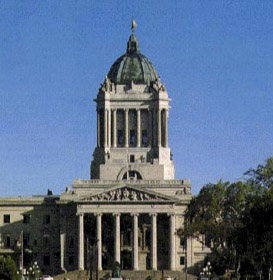
Manitoba Legislative Building (source: http://www.gov.mb.ca/mit/legtour/exterior.html)
Entering the very large Greco-Roman revival structure, we came face-to-face with the two guards on duty at their station. Friendly in that now familiar Canadian way, they waved us on. We stepped into a grand entry, and then walked about taking in the size and breadth a simple beauty of the place.
As the room was closed where the legislature meets, we removed ourselves again to the exterior (but not before we had to negotiate our way through a group of young Filipinos, all dressed in tuxedo and flowing dresses, a wedding party there for that pre or post wedding ceremony ritual, photographs! He was handsome, she radiant; all were intent on the best shots amidst the grandeur of the building. The Filipino population in Winnipeg exceeds 50,000 at this time, an influx not unlike that in the States).
Outside in the overcast, with a bit of a mist in the air, we walked to the back entrance of the Legislative Building toward the Red River walkway and the memorial of Louis Riel, which stands overlooking the river, intently gazing west.
We turned north to walk the biking / running pathway which courses through the western edge of the grounds. Passed by a cyclist or two, we soon came upon statues celebrating another prominent figure of Manitoba. Chicago has its cattle; Cincinnati has its pigs; Terre Haute has its horses; Indianapolis its race cars; Manitoba — its bears!
It was at this point that Albert informed me of the origin of Winnie-the-Pooh: Winnipeg! A story of a bear, its master traveling to England, the bear remaining with a family whose child grows up to write the stories of this child’s favorite! Albert was very proud to say Winnipeg spawned this bear; he also laughed when realizing how few people would have any idea! With the laughter still echoing, he posed with one of the gang. Nothing more need be said!
Unable to bear any more laughter, we strode toward our car for some more somber viewing: the Lieutenant Governor’s Residence (the current occupant is a Canadian of Chinese descent), and a statue of her majesty, the Queen. We were impressed by the residence; we paused, somewhat reverently, before the queen; no bows, though!
Our time was now becoming limited, as the Archbishop had an engagement with a seniors group of French-speaking actors celebrating their 25th anniversary of thespian fun. And so we returned to the grounds of the Archbishop’s House in smart time. We did have sufficient time to entertain one more statue. It seems that the statue of Louis Riel we had seen at the Legislative Building was the not the first on that pedestal. The original was removed in favor of what we had seen, that statesman-like figure. Albert abjured that one could only grasp the exchange by sighting.
The original is on the campus of the University of St. Boniface, adjacent to the Cathedral complex, within easy walk. We passed the main building of the University (Albert’s college alma mater where all classes are taught in French). The monument which the school erected stands to the east of this building. As I was left to decide why the exchange, so I will leave you to decide.
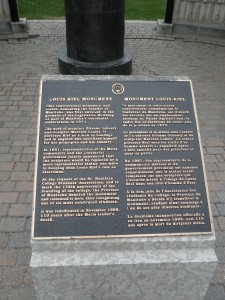
Plaque at Louis Riel Monument, campus of University of St. Boniface. Be sure to enlarge viewing of the photo to read (on the left) the English version of the history of this monument.
Our evening activities parted. Albert left for the Senior Thespians meal and vignette performances (later he declaimed them “delightful!“) I found my way to a delightful dinner and excellent conversation with the house residents, followed by some reading, watching the World Series (a good game), enduring for a time Notre Dame vs. USC (dismal), and awaiting His Grace’s return. When he sauntered in, we indulged once again in fruit, cheeses, crackers and some fine scotch, conversing about our day and looking toward the next. We retired in time, to sleep and then to rise for Sunday.


